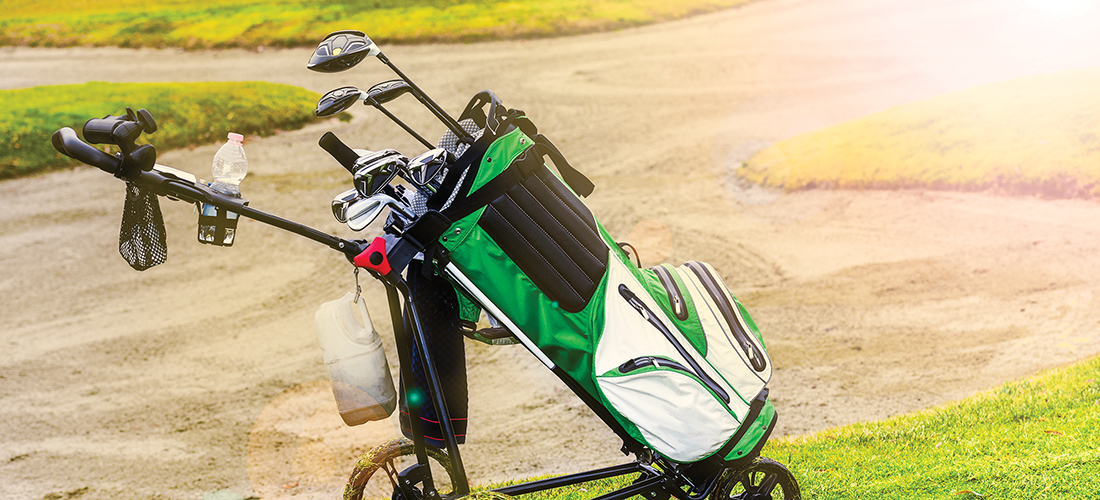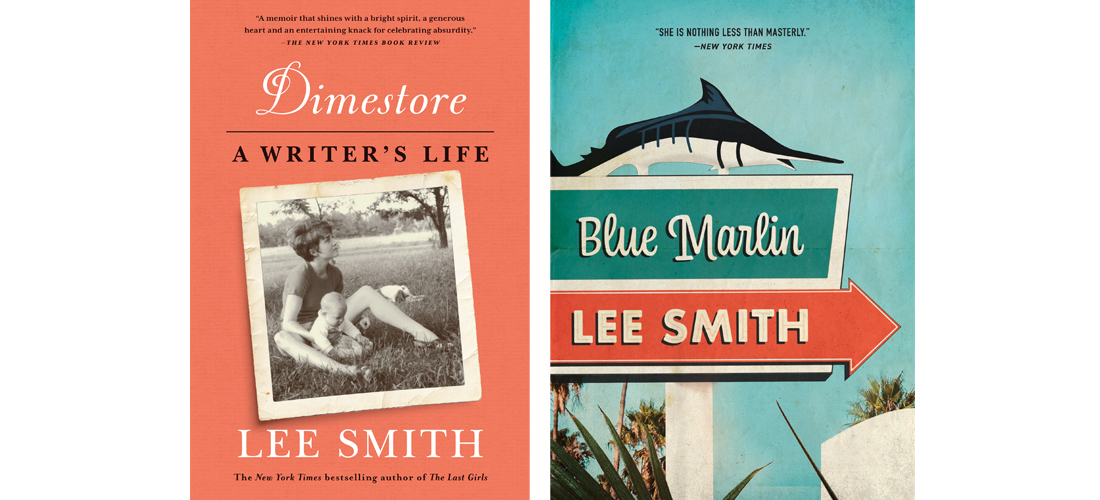
Trolley Line
The push and pull of golf
By Lee Pace
They are known as push carts, pull carts, caddie carts and trolleys. They are revered in some locales (e.g., the United Kingdom) and sniffed upon at others (many high-brow American clubs). They began as simple devices made of lawn mower tires mounted on a steel chassis and have evolved into high-tech gadgets powered by batteries and in some models with hands-free remote control.
But these gizmos that allow a golfer to walk the course but not have to carry his bag or employ a caddie are a key part of the walking landscape.
“At many clubs, players choose the carts because they are annoyed by the kid who smirks when a shot is missed,” noted a 1941 issue of Golfdom magazine.
“Caddies are scarce. Caddies are small. Caddies are arrogant,” noted another article.
Advertisements in Golfdom prove that these carts were available in the late-1930s and into the World War II years, when labor for caddies was restricted. One of the early models was dubbed the Kaddie Kart. Another early cart was conceived by Bruce Williamson in Portland, Oregon, in 1945, and evolved into the company that manufactured the Bag Boy Cart, which is still in existence though under a different owner.
“First a player will timidly try one and may feel a little self-conscious rolling the little cart along the fairways, but then he finds himself fresher and feeling better after his exercise,” a 1947 Golfdom article noted. “His shoulder does not ache and his scorecard shows better results.”
Sunningdale Golf Club outside London is a bucket list course for me, and a couple of years ago I noticed a Tweet from noted golf photographer David Cannon that showed Ernie Els and three golfers posing under a big tree outside the Sunningdale clubhouse. What caught my eye was the background — easily two dozen trolleys with bags on them idling between the building and the golf course. That’s the United Kingdom for you.
They hate “buggies,” as they call motorized carts. But they love “trolleys.”
“I don’t accept this stigma that a push cart is beneath a private club, because you go to Scotland and Ireland and Australia and all the top clubs have them,” says architect Gil Hanse.
“You can take a trolley at probably every course on the British Open rota, but you can’t at many of our top clubs in the States,” says former USGA Executive Director David Fay. “Something doesn’t add up.”
Trolleys are generally lumped into two categories: push carts have three wheels and pull carts have two. They are allowed today at top-rung golf destinations like Pinehurst, Bandon Dunes, Cabot Links and Streamsong, though policies vary on whether you can bring your own or use/rent one provided by the club.
Through the 1970s and ‘80s, as batteries and gas overtook the human gait as the preferred means of traversing a course, Pinehurst Resort and Country Club remained true to its traditional roots by offering a “Walking Club” to members who gathered in the afternoons to walk and carry their bags on No. 2. Fay used the program as a template for a similar program the USGA instituted in the 1990s to encourage walking across the nation.
Thankfully, the walking tradition has been healthy at most courses in the Sandhills. Pinehurst maintains a thriving caddie program, and certainly a popular bucket list item for many golfers is to play No. 2 with a caddie. Members have been allowed for quite a while to walk any course at any time, and the resort in 2017 green-lighted hotel guests the option to walk and carry as well. Now push carts are available on all courses, including No. 2 and the recently redesigned No. 4.
“We felt like walking is an important tradition in golf and something we should support,” says Director of Golf Ben Bridgers. “The trend has really changed the last few years. We’re seeing a lot of people grabbing their bag, throwing it over their shoulder or taking a pull cart. It’s pretty awesome. I played No. 4 recently, and that day you saw people carrying, taking a pull cart and taking caddies. Not many people walked No. 4 before the restoration. It’s going back in time; it has more of an old-time Pinehurst feel.”
Trolleys have become more prevalent in junior golf and college golf since 2008, when the American Junior Golf Association announced it would allow them in its competitions. Research by noted golf training entities such as the Titleist Performance Institute has revealed concerns about the constant grinding on the back and shoulders of golfers who carry their bags.
“Carrying your clubs not only places a huge amount of compressive force on your spine, but also causes lactic acid buildup in the surrounding muscles, causing fatigue and injuries,” says Dr. Josh Nelson, a sports chiropractor and TPI consultant.
Stanford University men’s golf team proved that push carts were here to stay on the collegiate golf level in the 2014 NCAA Championships when four of five Cardinal golfers used them. Stanford’s Cameron Wilson won that year’s individual title pushing a trolley.
At the PGA Merchandise Show in Orlando in 2018, I met Thomas Reiter, who formed a company called Big Max Golf in 1994 at first to service golfers in Germany and Austria and then expanding across Europe. Reiter named the company after his first-born son, Max, and started with a two-wheel pull cart. But he soon noted the stress that the pulling motion placed on the arm and shoulder.
“We were the first to weld a third wheel onto the two-wheel cart and turn it around,” Reiter says. “It was a simple change, but one that nobody had ever done before. It was less stressful on the arm, and it was easier to direct with the cart in front of you. We’d created the first three-wheel folding push cart.”
I tested the company’s flagship cart, the IP Blade, on several rounds in July 2019 and came away impressed with the engineering and the benefits of pushing a cart. The IP Blade fits compactly in the trunk of a car, folding to roughly 3-feet long by 2-feet wide by 3-inches deep. You take it from the car, and the three wheels fold out and the center console pops up. You adjust one lever to lock the console and you’re ready to go. The cart holds golf bags of any size with attachments high and low to keep the bag secure. There is an attachment for an umbrella and places to hold scorecards, tees, a GPS device and water bottle.
The cart pushes smoothly and can go almost anywhere you want to walk, though certainly not through traps or across greens. After 18 holes, my lower back wasn’t as sore nor my right shoulder stressed.
The company has been the leading trolley manufacturer for two decades now in Europe, where Reiter estimates 95 percent of golfers walk, and is gaining traction in the United States after opening a facility in Tacoma, Washington, in 2014.
“We are trying to get golfers to realize that carrying your golf bag is bad for your body and your game,” Reiter says. “You don’t see Tour players carrying their bags around, do you? By pushing a cart, you have time to contemplate your next shot, and you have more energy left over the closing holes. If you want a long, good golf career, you need to take good care of your body.”
The trolley has become more relevant in the golf world today in the wake of the COVID-19 pandemic that has ravaged life in general and the golf universe in specific over the spring of 2020. Many of the courses that remained open restricted use of motorized carts, acknowledging that “social distancing” is more easily practiced by golfers walking a fairway. Forest Creek Golf Club, for example, remained open but required golfers to walk, and many members embraced the use of a push cart, which had previously not been allowed at the 36-hole facility 3 miles northwest of the village of Pinehurst. Coming out of the quarantine, the club is now allowing permanent use of push carts.
And Big Max Golf saw a remarkable 800 percent jump in year-over-year unit sales of its Fold Flat push carts in March in states where golf was allowed during the pandemic.
“One of the things I hope comes out of this is that more people will enjoy the walking game,” says Pinehurst President Tom Pashley. “I think that can be a nice outcome — more people walking the golf course.” PS
Chapel Hill-based writer Lee Pace has written a book about the joys of walking some of the top courses in the Carolinas; the book is due out in 2021 from UNC Press.





